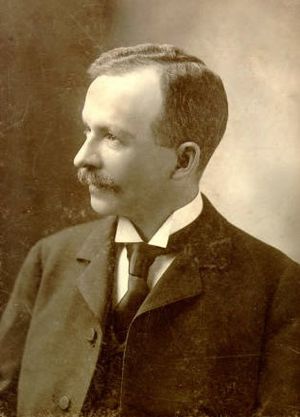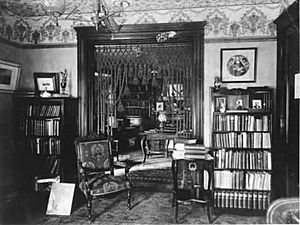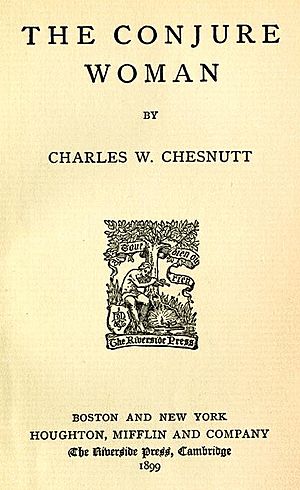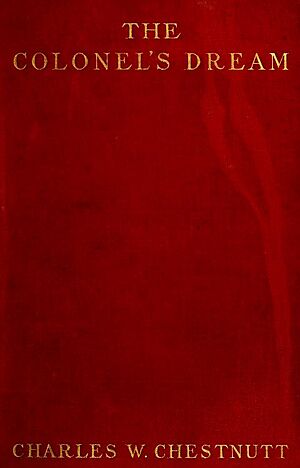Charles W. Chesnutt facts for kids
Quick facts for kids
Charles W. Chesnutt
|
|
|---|---|

Chesnutt at age 40
|
|
| Born | June 20, 1858 Cleveland, Ohio |
| Died | November 15, 1932 (aged 74) Cleveland, Ohio |
| Resting place | Lake View Cemetery |
| Occupation | Writer, political activist, lawyer |
| Spouse | Susan Perry |
| Children | 4 |
Charles Waddell Chesnutt (born June 20, 1858 – died November 15, 1932) was an American author, essayist, and lawyer. He was also a political activist. He is best known for his novels and short stories. These stories explored important topics like race and identity in the American South after the Civil War.
Two of his books were made into silent films in the 1920s. An African-American director named Oscar Micheaux made these films. After the Civil Rights Movement in the 20th century, people became very interested in Chesnutt's work again. Many of his books were republished. He also received special honors, including a commemorative stamp in 2008.
In the early 1900s, Chesnutt started a very successful court reporting business in Cleveland. This business provided most of his income. He also became active in the National Association for the Advancement of Colored People (NAACP). He wrote articles that supported education and legal challenges against unfair laws.
Contents
Early Life and Education
Charles Chesnutt was born in Cleveland, Ohio. His parents, Andrew and Ann Maria Chesnutt, were "free people of color" from Fayetteville, North Carolina. This meant they were Black people who were not enslaved. His grandfather on his father's side was a white slaveholder.
Chesnutt identified as African American. However, he noted that he was mostly white, about seven-eighths. He could have chosen to "pass" as a white man, but he never did. At that time, in many Southern states, he could have been legally considered white if he chose. Later, the "one-drop rule" became law in the South. This rule meant that if a person had any known African ancestry, they were classified as Black.
After the Civil War ended and enslaved people were freed, Chesnutt's family moved back to Fayetteville in 1867. Charles was nine years old. His parents ran a grocery store, where he worked part-time. But the store failed because of his father's poor business skills. The economy in the South was also struggling after the war.
As a teenager, Charles had to take care of his mother and siblings. His mother was very sick and later passed away. During this time, he published his first story in a small newspaper.
Chesnutt went to the Howard School in Fayetteville. This school was for Black students. It was one of many schools started by the Freedmen's Bureau during the Reconstruction era. By age 14, he became a pupil-teacher there to help with money. He received many job offers as a teacher. However, problems like funding issues often caused these offers to be taken back.
Chesnutt continued to study and teach. In 1877, he became an assistant principal at the normal school in Fayetteville. This was a school that trained Black teachers. By 1880, he became the school's principal and CEO. He resigned in 1883 to move to New York City and start a writing career.
Family Life
In 1878, Charles Chesnutt married Susan Perry. She was a young African American woman from a respected family. Five years later, they moved to New York City. They hoped to escape the prejudice and poverty of the South.
By 1898, they had three daughters: Helen, Ethel, and Dorothy. They also had one son, Edwin. Their second daughter, Helen Maria Chesnutt, became a well-known scholar. She wrote a book about her father's life. She tried to tell his story accurately and with many details.
Legal and Writing Career
Chesnutt wanted to be a writer. He hoped to support his family through writing. He also wanted to use his writing to improve race relations and share his thoughts on society.
After six months in New York City, Chesnutt realized he could not raise a family there. So, the Chesnutts moved to Cleveland. In 1887, he studied law in Cleveland and passed the bar exam. Chesnutt had learned stenography (a fast way of writing) when he was young. He used this skill to start a very profitable court reporting business. This made him financially successful.
Chesnutt also started writing stories. Top national magazines published his work. In August 1887, The Atlantic Monthly published his first short story, "The Goophered Grapevine." This was the first time an African American writer had a story published by The Atlantic.
In 1890, he tried to get his novel, A Business Career, published. The editor, Walter Hines Page, said Chesnutt needed to be more famous first. This novel was about white characters. It was found among Chesnutt's papers and finally published in 2005.
His first book was a collection of short stories called The Conjure Woman. It was published in 1899. These stories featured Black characters who spoke in African American Vernacular English. This was a common style in Southern literature at the time.
That same year, he published another short story collection. It was called The Wife of His Youth and Other Stories of the Color-Line (1899). This book included stories like "The Wife of His Youth" and "The Passing of Grandison". These stories challenged common ideas about enslaved people and their desire for freedom. They also brought up new questions about African-American culture. The editors at The Atlantic strongly supported Chesnutt's writing. He worked with the magazine for 20 years.
Chesnutt's stories about racial identity were very complex. He wrote about characters dealing with difficult issues. These included being of mixed race, "passing" as white, and questions about racial identity and social status. His story "The Wife of His Youth" explored how skin color and social class were viewed within the Black community. This was especially true for families who had been free before the Civil War.
These issues were very important during the time of Reconstruction. White people in the South tried to regain control in society, business, and politics. They used violence and stopped Black people from voting. From 1890 to 1910, Southern states passed new laws. These laws made it hard for most Black people and many poor white people to vote. This was done through things like Jim Crow rules and disfranchisement.
Chesnutt continued writing short stories. He also wrote a biography of Frederick Douglass. Douglass was a famous abolitionist who escaped slavery. Chesnutt then started writing longer novels. He wanted to express his strong feelings about activism. The Atlantic published his first novel, The House behind the Cedars (1900).
His novel Marrow of Tradition (1901) was based on the Wilmington Massacre of 1898. This was a terrible event where white people took over the city. They attacked and killed many Black people. They also removed the elected government, which included both Black and white leaders. This was the only coup d'état (when a group illegally takes control of a government) in U.S. history.
Chesnutt wrote several other novels. Some of them were published after he died. He also traveled and gave lectures in different states, mostly in the North.
His novels were not as popular as his stories. This was because the novels directly challenged the social and political problems of the time. However, other writers of his era respected Chesnutt. For example, in 1905, he was invited to Mark Twain's 70th birthday party.
Even though his stories were praised, his novels did not sell well. This meant he could not make a living just from writing. His last novel, The Colonel's Dream, was published in 1905. It was about a former Confederate colonel who returned to his hometown in North Carolina. He hoped to make the town better.
In 1906, he wrote a play called Mrs. Darcy's Daughter. But it was not successful. After that, Chesnutt did not write or publish much before he died in 1932.
Chesnutt's Writing Style
Charles Chesnutt's writing style is a mix of "local color" and "literary realism." Local color writing focuses on the unique customs and speech of a certain region. Literary realism tries to show life as it truly is.
One of his most important works was The Conjure Woman (1899). This book is a collection of stories set in North Carolina after the Civil War. The main character is Uncle Julius, a formerly enslaved man. He tells a white couple from the North fantastical stories about life on a plantation before the war.
Uncle Julius's tales include supernatural things like ghosts and magic. These were common in Southern African-American folk tales. But Uncle Julius also tells these stories in a way that helps him achieve his own goals. His tales are similar to Joel Chandler Harris's Uncle Remus stories. However, Chesnutt's stories also indirectly comment on slavery and racial inequality. They show the psychological and social effects of these issues. Some people argue that these stories use African American stereotypes. But most critics agree that the stories are important because they use metaphors to show racial injustice.
Seven of the Uncle Julius tales were in The Conjure Woman. Chesnutt wrote 14 Uncle Julius tales in total. The rest were collected later in The Conjure Woman and Other Conjure Tales, published in 1993.
In 1899, Chesnutt published The Wife of His Youth and Other Stories of the Color-Line. This was a collection of short stories written in a realistic style. He explored many themes that Black writers in the 20th century also used. These included:
- Color prejudice among Black people.
- The dangers of "passing" as white.
- The sadness of mixed-race children.
- The problems of city life and mixed marriages in the North.
- Unfair justice in small Southern towns.
Both collections were highly praised by William Dean Howells. He was an important novelist and critic. In 1900, he wrote a review in The Atlantic Monthly called "Mr. Charles W. Chesnutt's Stories." Howells said that Chesnutt's stories should be seen as "works of art" first, not just for their "racial interest."
The House Behind the Cedars (1900) was Chesnutt's first novel. He wanted to show a more realistic picture of race and social relations in the South. He also wanted to talk about issues like miscegenation (marriage or relationships between people of different races) and passing, which people often ignored.
The novel tells the story of Rena Walden, a young, light-skinned, mixed-race woman. She joins her brother in another town, where he is already passing as white. Rena falls in love with a white man. When he learns she has Black ancestry, he breaks off their engagement. He then tries to get her to be his mistress. Rena leaves to teach at a Black school. She is attacked there by a lower-class mixed-race man. She tries to return to her mother but dies on the way. A Black friend helps her during her journey.
The Marrow of Tradition (1901) was a turning point for Chesnutt. It was set against events similar to the Wilmington Race Riot. The novel features important white characters and a Black doctor who returned from the North. It explores the difficulties the doctor faces in a prejudiced Southern town. Among the characters are half-sisters, one white and one Black, who share the same white father. They meet during these events. In this novel, Chesnutt started to address political issues more directly. He talked about sensitive topics like racial "passing" and lynching. This made many readers uncomfortable.
Many reviewers criticized the novel's strong political message. Some of Chesnutt's supporters, like William Dean Howells, found its tone "bitter." They thought it had more "justice than mercy." Middle-class white readers, who usually liked Chesnutt's earlier works, found the novel shocking and even offensive. It did not sell well.
His last novel, The Colonel's Dream (1905), was a sad story. It was about an idealist who tried to improve a struggling North Carolina town. The book received little attention and sold few copies. Chesnutt then gave up on being a full-time writer. He focused on his court reporting business, gave lectures, and became an activist with the NAACP.
Later, during the Harlem Renaissance, many new writers emerged. They thought Chesnutt's style was old-fashioned. Some even believed he was using racial stereotypes. So, Chesnutt's literary reputation faded.
However, starting in the 1960s, the Civil Rights Movement brought new attention to African-American life and artists. People began to re-evaluate Chesnutt's work. Critics now focus on his complex writing techniques, his subtle messages, and his use of irony. Many praise Chesnutt's exploration of racial identity. They also admire how he used African-American speech and folklore. His criticism of the unfair logic behind Jim Crow laws is also highlighted. Chesnutt's longer works helped lay the groundwork for the modern African-American novel.
Selected Works
- The Conjure Woman (1899): A collection of seven short stories. They explore themes of personal and racial identity after the Civil War.
- The Wife of His Youth and Other Stories of the Color-Line (1899): A collection of nine short stories. They take place in North Carolina and Ohio. They focus on Jim Crow laws and the racial prejudice of the time.
- "The Wife of His Youth": This is one of Chesnutt's most famous short stories. It looks at race relations within the Black community.
- "The Passing of Grandison": A short story set during the abolitionist movement. It addresses the issue of racial "passing."
- Frederick Douglass (1899): A biography of the famous abolitionist, Frederick Douglass.
- The House Behind the Cedars (1900): A novel set in the Carolinas after the Civil War. It focuses on racial relations and identity in the post-war South.
- The Marrow of Tradition (1901): A novel that shows a fictional version of the Wilmington Insurrection of 1898. It challenges exaggerated accounts of the event.
- The Colonel's Dream (1905): A novel set in the post-Civil War South. It shows the racial violence and oppression of that time.
Published After His Death
- A Business Career - (Written in the 1890s; published 2005) A novel about a woman who wants to start a business in the late 1800s. It comments on the rise of new women in American society.
- Mandy Oxendine - (Written in the 1890s; published in 1997) A novel that questions the idea that a person's identity decides their role in society.
- Paul Marchand, F.M.C. - (Written in 1921; published 1998) A novel that focuses on mixed-race marriage and the negative feelings against it.
- Evelyn's Husband - (Published 2005) A novel about a high-society love triangle in the early 1900s. It focuses on themes of love.
- The Quarry - (Written 1928; published 1999) A novel focusing on the culture of Harlem in the 1920s.
Books Made into Films
In 1926, The Conjure Woman was made into a film by Oscar Micheaux. The film had the same name.
In 1927, The House Behind the Cedars was also made into a film by Oscar Micheaux.
In 2008, a student named Dante James made a film based on Chesnutt's short story The Doll. This story was first published in 1912. The film won several awards, including "Best Actor" for Clayton LeBouef at the San Diego Black Film Festival. It also won "Best Short Film" at The Sweet Auburn International Film Festival.
Views on Race Relations
Chesnutt's ideas about race relations were somewhere between the views of W. E. B. Du Bois and Booker T. Washington. In 1905, he gave a speech called "Race Prejudice; Its Causes and Its Cure." In this speech, he talked about ending racial conflict "stone by stone" as the Black middle class grew. He used facts and numbers to show the history of Black achievements and to discuss poverty. He called for full rights for African Americans.
Chesnutt did not like the idea of "race pride." Instead, he imagined a nation where everyone was "one people" with the same culture. He ended his speech with a powerful statement. It was made 58 years before Dr. Martin Luther King Jr.'s "I Have a Dream" speech:
Looking down the vista of time I see an epoch in our nation's history, not in my time or yours, but in the not distant future, when there shall be in the United States but one people, moulded by the same culture, swayed by the same patriotic ideals, holding their citizenship in such high esteem that for another to share it is of itself to entitle him to fraternal regard; when men will be esteemed and honored for their character and talents. When hand in hand and heart with heart all the people of this nation will join to preserve to all and to each of them for all future time that ideal of human liberty which the fathers of the republic set out in the Declaration of Independence, which declared that 'all men are created equal', the ideal for which [William Lloyd] Garrison and [Wendell] Phillips and [Sen. Charles] Sumner lived and worked; the ideal for which [Abraham] Lincoln died, the ideal embodied in the words of the Book [Bible] which the slave mother learned by stealth to read, with slow-moving finger and faltering speech, and which I fear that some of us have forgotten to read at all-the Book which declares that "God is no respecter of persons, and that of one blood hath he made all the nations of the earth."
Social and Political Activism
Starting in 1901, Chesnutt put more energy into his court reporting business. He also became more involved in social and political activism. In 1910, he joined the General Committee of the new National Association for the Advancement of Colored People (NAACP). He worked with important leaders like W. E. B. Du Bois and Booker T. Washington. He became one of the most well-known activists and commentators of the early 20th century.
Chesnutt wrote short stories and essays for The Crisis, the NAACP's official magazine. He did not get paid for these writings. He wrote a strong essay protesting how Southern states successfully stopped Black people from voting. These states passed new laws that made it very hard for Black people to register to vote. This included poll taxes and literacy tests. Even though there were appeals to the U.S. Supreme Court, these laws mostly stayed in place.
In 1917, Chesnutt protested showings of the film The Birth of a Nation in Ohio. This film was very controversial. It glorified the Ku Klux Klan, a group that used violence against freed Black people. The NAACP officially protested the film across the country. In Ohio, Chesnutt helped get the film banned.
Charles Chesnutt passed away on November 15, 1932, at age 74. He was buried in Cleveland's Lake View Cemetery.
Legacy and Honors
- In 1913, Chesnutt received an honorary law degree from Wilberforce University.
- In 1928, he was awarded the NAACP's Spingarn Medal for his life's work.
- In 1987, the Charles Waddell Chesnutt Library was built at Fayetteville State University in North Carolina. Chesnutt had been the second principal of the Howard School, which later became Fayetteville State University.
- On January 31, 2008, the United States Postal Service honored Chesnutt with the 31st stamp in the Black Heritage Series.
- Several of Chesnutt's works, including essays, have been published after his death. In 1989, William L. Andrews wrote that Chesnutt is now seen as a major innovator in African American fiction. He is also considered an important writer who showed a more realistic view of the South after the Civil War.
See Also
- African American literature
- The Conjure Woman (film version by Oscar Micheaux)
- The House Behind the Cedars (film version by Oscar Micheaux)




